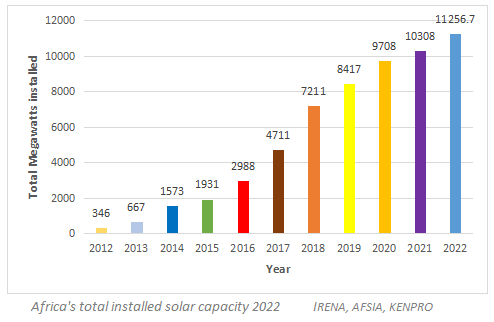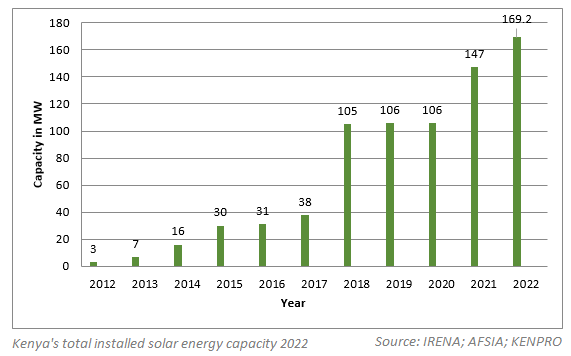By Anthony M. Wanjohi:
Global demand for renewable energy sources including solar, biogas among other green energy sources is expected to rise as the world adapts to the changes in climate. According to Bloomberg New Energy Finance, by 2030 renewable energy will account for 65% of the $7.7 trillion in power investment.
Africa has a huge solar energy investment potential. In 2020, 733 million people were still without power. In most African countries, off-grid solar solutions are the most important technology to enhance Sustainable Development Goal 7 progress in the near future. High-level study shows that off-grid solar technologies are anticipated to be the least expensive option for 41% of new household connections between 2020 and 2030, on a trajectory to attain universal access to energy.
In essence, Africa hosts about 1% of the total global solar energy capacity installed. By 2022, Africa had a total of about 11,000 MW (11GW) of installed solar energy capacity compared to world’s 1,000 GW. The figure below shows Africa’s total installed solar energy capacity from 2012 to 2022.
Kenya accounts for only 1% of Africa’s total solar energy capacity. However, over the span of a decade, the solar energy sector in Kenya witnessed significant growth in capacity. Starting at a modest 3 MW in 2012, the capacity gradually increased to 7 MW in 2013 and further surged to 16 MW in 2014. The following years showed a steady upward trend, with the capacity reaching 30 MW in 2015 and 31 MW in 2016. The growth continued as the capacity in 2017 was 38 MW and experienced a remarkable growth to 105 MW in 2018. From 2019 to 2020, the capacity remained relatively stable at around 106 MW. However, in 2021, there was a substantial increase, reaching 147 MW, followed by a significant rise of approximately 169.2 MW of Kenya’s total installed solar energy capacity by 2022. However, this figure excludes residential solar installations. The figure below shows estimated installed solar energy capacity between 2012 and 2022 in Kenya.
From this review, solar market and growth in Kenya, and generally in Africa appears to be quite promising with an ever increasing global call for sustainable and affordable sources of power. Many governments in Africa have continued to create conductive legal and regulatory environment for growth of solar. Kenya is on the lead in the region in terms of the formulation and implementation of friendly solar energy policy framework. As such, solar market in Kenya and Africa at large is huge and promising!
Resources for Further Reading
AFSIA (2023). Annual Solar Outlook 2023. Rwanda: AFSIA
IRENA (2022). Renewable Energy Statistics 2022. Abu Dhabi: IRENA
![]() Download Printer Friendly Copy
Download Printer Friendly Copy
For more inquiries about Solar Installations at household and institutional levels, kindly contact Kenpro Solar Program Team or call us via +254725788400.


